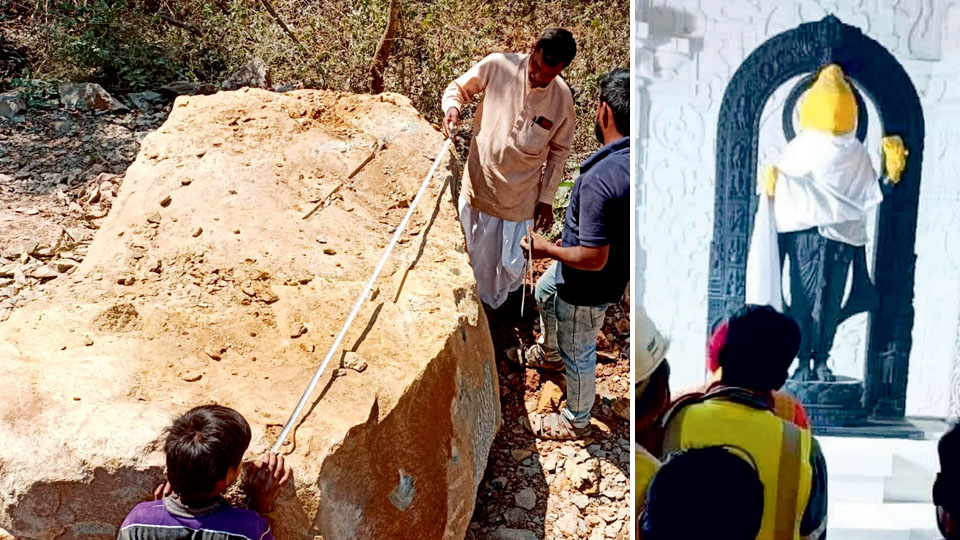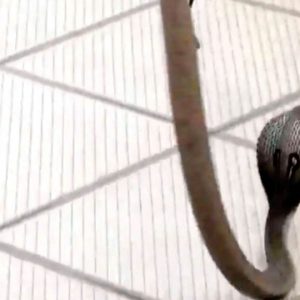Azure-coloured Krishna Shile is the oldest rock from South India, says city Professor
Mysore/Mysuru: The idol of Lord Ram (Ram Lalla), carved by Mysuru sculptor Arun Yogiraj and now gracing the sanctum sanctorum of Sri Ram Temple in Ayodhya, has been chiselled out of a three-billion-year-old rock, according to Dr. C. Srikantappa, UGC-Emeritus Professor (retired), Department of Earth Science, University of Mysore.
He said that based on extensive geological, petrological, and geochronological studies carried out by the Department of Earth Science, for more than three decades, it has been found that the rock used to carve the idol of Sri Ram Lalla is the oldest rock from South India.
The azure-coloured Krishna Shile (black schist) was excavated from Gujjegowdanapura at Jayapura Hobli in H.D. Kote Taluk. It is a fine to medium-grained, sky-blue-coloured metamorphic rock and this type is generally called soapstone, because of its smooth surface texture and is an ideal rock for sculptors to carve idols, he said.
Dr. Srikantappa said that geologically, rocks around Mysuru form a part of Archaean-Dharwar craton. The basement rocks exposed around Mysuru are sialic (rich in silica and alumina) in composition, termed Peninsular gneiss. U-Pb (uranium and lead) isotopic studies of zircon grains in gneissic rocks give an age of 3.4 billion years, suggesting that they are the oldest rocks exposed in South India. Such rocks are exported now to Europe from Mysuru region for ornamental purposes, he told Star of Mysore.
A group of metasedimentary rocks consisting of quartzites, carbonates, iron stones and pelitic rocks have been deposited on these basement rocks. These rocks are well-exposed around Sargur town towards the southwest of Mysuru city and hence the name ‘Sargur Schist Belt’ is coined. The presence of sedimentary rocks in the region indicate that the area was submerged under the sea in the geological past, he explained.
“A group of plutonic, layered igneous rocks of upper mantle origin of ultramafic-mafic (dark in colour and very low silica content) in composition have been intruded into sedimentary rocks of Sargur Group over three billion years ago. Based on mineralogical studies, ultramafic-mafic rocks show variation in composition from dunite, harzburgite, lherzolite, peridotites, pyroxenites and gabbros. Dunites contain chromites and magnesite which were mined at Doddakanya, Sinduvalli and Hullahalli near Mysuru,” he said.
Chamundi Hill 700 million-years-old
Samarium-Neodymium (Nd-Sm) dating method applied to metamorphic garnet and zoned zircon within metamorphosed sediments of Sargur rocks establishes a metamorphic age of 2.5 billion years. In city, Chamundi Hill serves as a notable landmark, showcasing the youngest intrusive rocks of granitic composition, aged at 700 million years. Radiometric dating for these findings was conducted at IIT, Kharagpur and University of Bonn, Germany, he noted.
The rocks underwent high-grade metamorphism, where original igneous minerals such as hypersthene, diopside, plagioclase and spinels underwent alteration to secondary minerals like green-coloured actinolite/tremolite, white-coloured talc, green to sky-blue-coloured chlorite and red-coloured iron oxide.
This alteration rendered the rock soft, leading to the use of the term soapstone. The resulting altered rock exhibits a greenish to sky-blue hue, varying based on the modal amounts of minerals present, with a linear to medium-grained texture.








Recent Comments